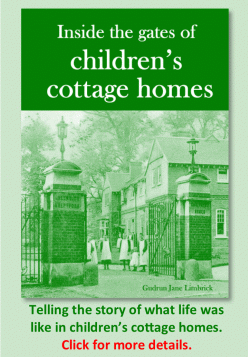|
Cottage Homes
Following the Poor Law Amendment Act of 1834, the general means by which poor or desititute people were looked after was the workhouse.
Charles Dickens got it right in Oliver Twist when he described the overcrowded, harsh conditions in the workhouse. And it certainly wasn't unusual for children such as Oliver to be in the workhouse - between a third and a half the people in workhouses were children. Some went into the workhouse with their parents, others had parents who were unable to support them and some were orphans or had been abandoned by their families.
In the late 19th century, it was decided that the workhouses were not the best place for children, in part because the adults they were housed with could be bad influences.
Instead, cottage homes were built - each a series of buildings (known as cottages but generally large houses) in which perhaps 20 or 30 children were housed. Many cottage homes had their own facilities such as schools, chapels and infirmaries - some even had their own farmland from which the children and staff could be fed.
Generally each unit of cottage homes would be overseen by a superintendent and each individual cottage would be run by a woman or a couple who lived on the premises with their charges.
Life in the cottage homes, mirroring workhouse life, was designed to be disciplined with strict routines for schooling and mealtimes. In most cottage homes children were given a uniform. Many of the homes attempted to furnish the children for life after the homes not only by basic schooling but also by teaching them a trade or, for girls, skills they could use in domestic service. Initially everything the children needed was provided on site - schools, churches, sports and recreation facilities and training workshops so children rarely or never left the premises.
The later years
Cottage homes were very much a Victorian invention. However, many lasted far longer than either Queen Victoria or the workhouses with which they were associated.
Residential childcare was still needed long after the workhouses went and long after the Poor Law Unions who initially built and ran the cottage homes. In many areas, the running of the cottage homes was taken over by the local authorities and the new city councils used the buildings to accommodate children in care. Some cottage homes lost their Victorian discipline over the years and became streets of modern children homes rather than single units of cottage homes. Children no longer spent all their time behind the gates of the cottage homes but went out to local schools and used local amenities.
In the latter half of the twentieth century, the emphasis changed from taking in mainly orphans and destitute children to also providing care for children with behavioural problems or disabilities and for children who had experienced family breakdown, neglect or abuse. While children were initially taken into cottage homes on a long-term basis, it became more common in later years for children to be taken in for shorter time periods.
In later years, it became more likely for children in need to be placed with foster families rather than children's homes and there are generally fewer children's homes. Additionally, the original cottage homes buildings were thought to be no longer appropriate as children's homes - being, in the main, large, outdated, draughty Victorian buildings with dormitory-style accommodation. From the 1960s, the cottage homes buildings began to lose their childcare functions.
Some of the cottage homes effectively did not close until the 1970s or 1980s. One example is Shenley Fields Cottage Homes in south Birmingham which remained in use as children's homes until the late 1980s - closing 100 years after they first opened.
There are also cottage homes for adults. More details are here.
© Gudrun Limbrick 2018
| ||||||

 -------------------------------------------------
-------------------------------------------------






